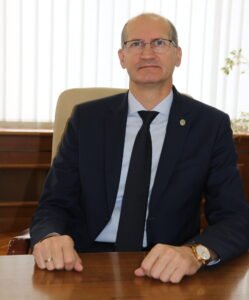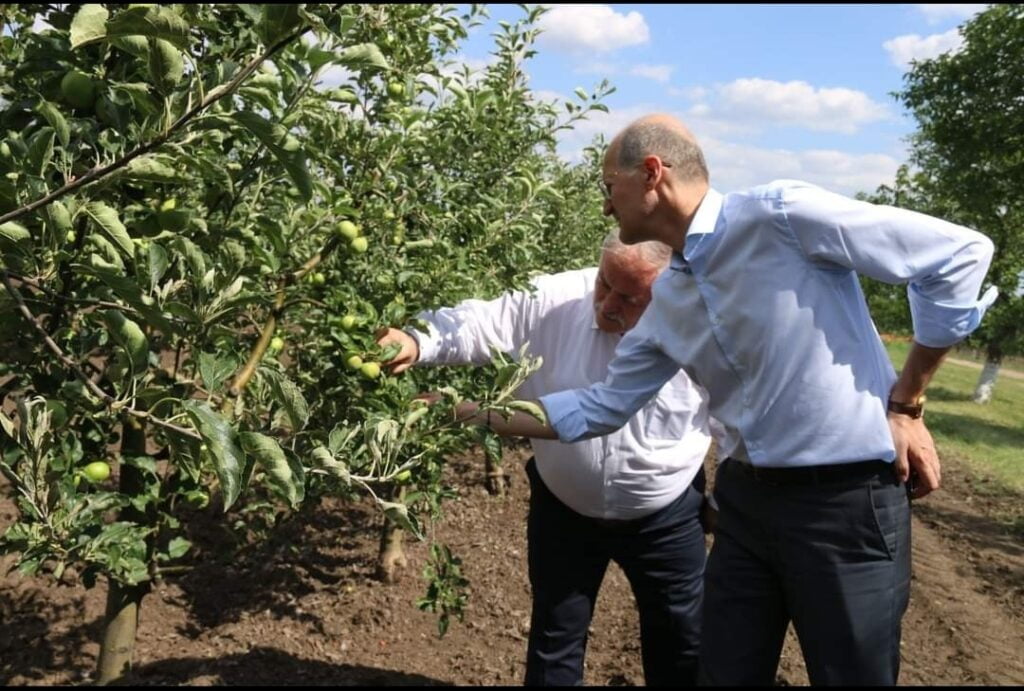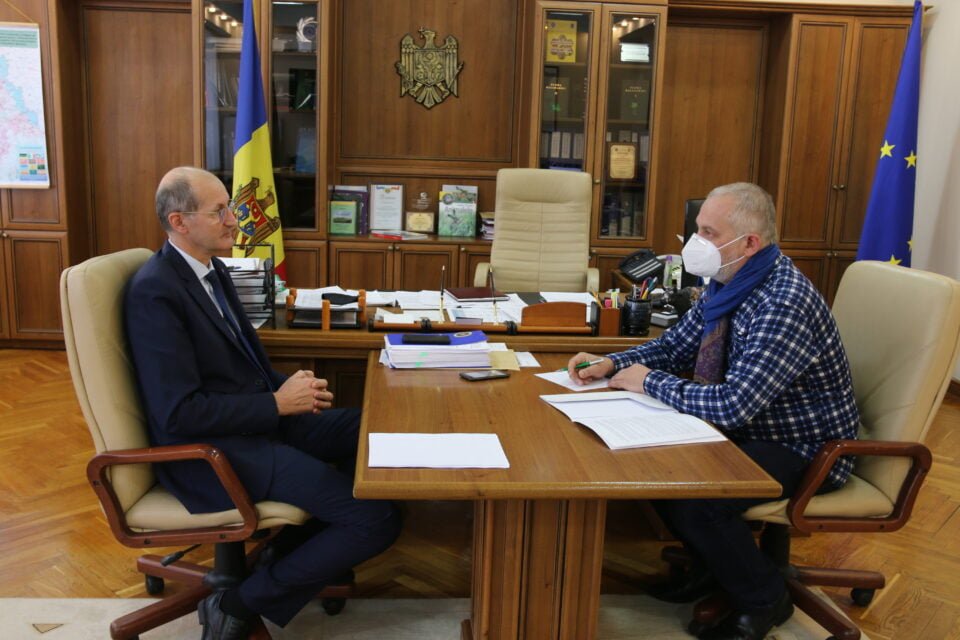On November 18, 2020, the Government of the Republic of Moldova approved the Horticulture Development Program for 2021-2025 and the Action Plan for its implementation. EastFruit sat down with Ion Perju, Minister of Agriculture, Regional Development, and Environment of the Republic of Moldova, to discuss this program and more.

– Mr. Minister, what is the aim of the development program, and what are its ultimate goals?
– The program aims to consolidate efforts and activities in the horticulture sector and is primarily focused on sustainable development. It seeks to strengthen the competitiveness and resilience of the horticultural sector by increasing the value of products and deeper integration of the value chain, with a focus on sustainable rural development. The program provides for certain goals that will be achieved by 2025 in the course of its implementation. Thus, we intend to expand access to external markets, improve the competitiveness of the workforce and the business climate. At the same time, we are confident that the program will increase the efficiency of the country’s horticultural sector and will promote development and innovation, which are the elements that provide profit to enterprises and revenues to the state budget.
– How will the program be implemented, and how will specific indicators be identified?
– It should be clarified that the action plan provides for a phased implementation and specific milestones have been set. For example, the expansion of perennial plantations has been established such as the creation of new intensive and super-intensive orchards with an area of about 21,800 hectares. Other specific indicators include an increase in the total volume of fruit production by 508,700 tons or 35%; an increase in the total production of vegetables by 433,000 tons or 45%; an increase in the average yield of horticultural products per hectare by 40%; and an expansion of irrigated areas through investments by 91,100 hectares. Also, the program seeks to expand the storage capabilities for fruit by building new refrigerated warehouses for 338,000 tons of fruit, packing factories for 45,000 tons of fruit, expanding closed areas for growing vegetables by 5,000 hectares, increasing the export of horticultural products in value terms by $200 million, and more. Moldova’s Horticultural Development Program for 2021-2025 is based on an in-depth analysis assisted by external partners including USAID.
– This is a bold plan and its impact will ensure significant growth in horticultural production in the Republic of Moldova. Where will these products be sold – on the domestic or foreign market?
– The domestic market is provided with our horticultural products, but in reality, the consumption of fruits and vegetables in the country is insufficient. I am in favor of increasing domestic consumption of local products. This will have a direct positive effect on consumers, producers, and the entire horticultural industry. Also, it is obvious that the diversification of the external market is necessary, which I have always spoken in favor of. While serving as Deputy Director of the Competitiveness and Agricultural Development Project (ACED), I stated that those objectives were to diversify the market and focus on access to European markets. We are doing a lot of work on sales in the Russian market because when adopting plans to develop new markets, it is very important not to forget about traditional ones. Farming is an important structural element of our country’s economy as well as a source of employment and income in rural areas. In this sector, there are more than 1000 companies directly involved in the primary production and the subsequent processing of fruits and vegetables. This industry employs more than 10,000 people and the annual turnover is more than 5 billion lei. Thus, it has a clear multiplying effect on other sectors of the economy along the entire value chain.
– What other markets for the sale of horticultural products in Moldova are you talking about besides the markets of Russia and the European Union?
– Efforts were conducted to gain access to the European and Middle Eastern markets. I personally have been on a business trip to Dubai, which is an extremely vast market. It is vital that in order to sell goods in markets where there are consumers and good prices, governments can provide tools and leverage to support producers and exporters. These tools are primarily tax adjustments, bilateral agreements on free exchange, and tax abolition, which creates a prerequisite for entry into one or more markets. For example, if we are talking about local apples, let’s start with the fact that we have an export quota of 40,000 tons without customs duties to the European market. Supplying our apples to the European market has been going on for years. Today, not only are our apples in demand in Europe, but also plums, table grapes, and cherries. Also, 98% of our apples are sold on the Russian market.
– How many apples are expected to be sold on the Russian market this year?
– According to estimates for this year, approximately 220,000 tons of apples will be sold on the Russian market and only 6,000-7,000 tons on the EU market. The rules, offers, and selling prices are dictated by the market. Therefore, our products will be competitive when we export Moldovan apples to Poland and wine to France, Italy, and Spain. Another important aspect is our image. We have very good products, but they are not well known yet. In this regard, we need to redouble our efforts, including through the embassies of the Republic of Moldova in other states, to strengthen our work in this area. It is also necessary to act on the domestic market. I want Moldovan fruits and vegetables to occupy more than 50% of our store shelves in compliance with the principle of competitiveness. The slogan “We Buy Moldovan Products” should be widespread.

– Fruit and vegetable producers in Moldova invest mainly in intensive and super-intensive farms. These farms require the installation of irrigation systems at the very beginning. Is there a plan to develop the irrigation systems nationwide?
– It should be noted that the effective and efficient development of this sector largely depends on access to safe water sources for irrigation. Measures have been taken to rehabilitate our irrigation systems, which are in serious need of repair and have been impeding the development of the agricultural sector. Currently, there are 78 centralized irrigation systems in the Republic of Moldova, which only cover 130,600 hectares compared to 330,000 hectares irrigated in the 1990s. For the rehabilitation, modernization, and expansion of centralized irrigation/drainage systems and the rehabilitation of about 117 pumping stations, about 4.2 billion lei (75,000 lei/1 hectare) are needed to increase the area of irrigated land by about 68,000 hectares. MADRM is engaged in intensive dialogue with development partners to direct funding sources in order to achieve our desired drought prevention and mitigation goals. However, another concern is also manifesting itself. If we do not change the current state of affairs soon, then one day it may turn out that there is nothing to irrigate due to soil degradation. There is a direct correlation between lack of moisture and soil degradation as precipitation water is not absorbed. In the south of our country this year, there were heavy rains that simply washed the soil and did not increase its moisture content. We must keep our soil fertile, which is a true treasure of the Republic of Moldova.
– What actions have been taken to eliminate the consequences of the pandemic for the agricultural sector in Moldova?
– The pandemic began during a climatic period unfavorable for agriculture in Moldova and problems only worsened. Balancing measures and policies to provide government assistance to farmers with support from partner states and the donor community were offered in the form of numerous tax incentives and subventions, which contributed to a significant stabilization. To partially cover losses incurred, 300 million lei was allocated. Then, another 24 million lei was allocated to farmers on a supplementary list who were not included in the initial list due to assessment errors by I and II level authorities.
Additionally, we worked intensively with financial institutions to help farmers facing difficulties with loans repayments. The Prime Minister as well as the leadership of the Ministry of Agriculture consulted with credit and banking sector representatives for agreements to extend loans and address the coverage of interest on agricultural loans to avoid pressure on farmers during this difficult time. The same applied to VAT refunds since many farmers had funds blocked in VAT accounts. However, it was possible to use these funds to offset payroll taxes and other payments such as land taxes.
In the near future, a draft government decree on the distribution of financial resources from Russia totaling approximately 60 million lei will be approved. These funds will be offered to farmers mainly for corn production since this crop has been severely affected and is grown by almost all farmers. It will be necessary to distribute these funds as soon as possible.
– How were you able to interact with development partners during the pandemic?
– In order to overcome and mitigate the effects of the pandemic, we maintained intensive communication with representatives of international financial organizations such as the Food and Agriculture Organization of the United Nations, International Fund for Agricultural Development, World Bank, and others. The main topic of discussion was identifying and combating the effects of COVID-19 on the agricultural sector. We also held discussions with my colleagues from Belarus, Romania, and Ukraine. In the first months of the pandemic, the necessary measures were taken so as not to harm the market and sales of products since during this period public markets were closed. To remedy the challenging situation, mobile commerce was allowed.
After this experience, everyone agrees that markets or shops cannot be closed since agriculture is connected with biological systems – animals must be fed, crops must be sown at a set time, watering is needed, and so on. Life must continue with all the rigors required by the pandemic and we cannot stop agricultural activities since it is an industry that plays a vital role in the national economy. With the support of international organizations, necessary quarantine recommendations were developed for fieldwork, the food industry, and wineries. All measures must be observed such as social distancing, use of disinfectants, protective masks and gloves, and the temperature measurement of workers and others. These new measures are driving up costs, but citizen health costs much more.
In the first months of the pandemic, the wine industry was affected primarily because the hotel and restaurant sector was paralyzed. Cafes, bars, restaurants, and other establishments were all closed. Also, the tourism industry suffered greatly and this had a negative impact as well. It is much easier to retail wine to tourists than to organize wine export operations. Thus, in the first three months of the pandemic, the trade of wine products decreased by 10-20 percent. Other industries did not suffer as much, because, again, the necessary measures were promptly taken. The volume of exports suffered in the first months of the pandemic because some customs posts were closed by our neighbouring countries Ukraine and Romania. In this regard, exporters were redirected to existing checkpoints, and subsequently, all state border crossing points were opened.

– What is the role of development partners and specialized international financial institutions in strengthening and developing the national agricultural sector?
– Our ministry is constructively cooperating with external development partners. We are involved in a number of joint projects that have a significant impact on the modernization of sectors related to the ministry. The Food and Agriculture Organization of the United National (FAO), International Fund for Agricultural Development (IFAD), World Bank (WB), United States Agency for International Development (USAID), European Investment Bank (EIB), and partner governments are just a few examples of our reliable partners who support our government in meeting our agenda priorities aimed at creating, promoting, and modernizing a strong and sustainable agri-food sector in Moldova.
The use of the site materials is free if there is a direct and open for search engines hyperlink to a specific publication of the East-Fruit.com website.




